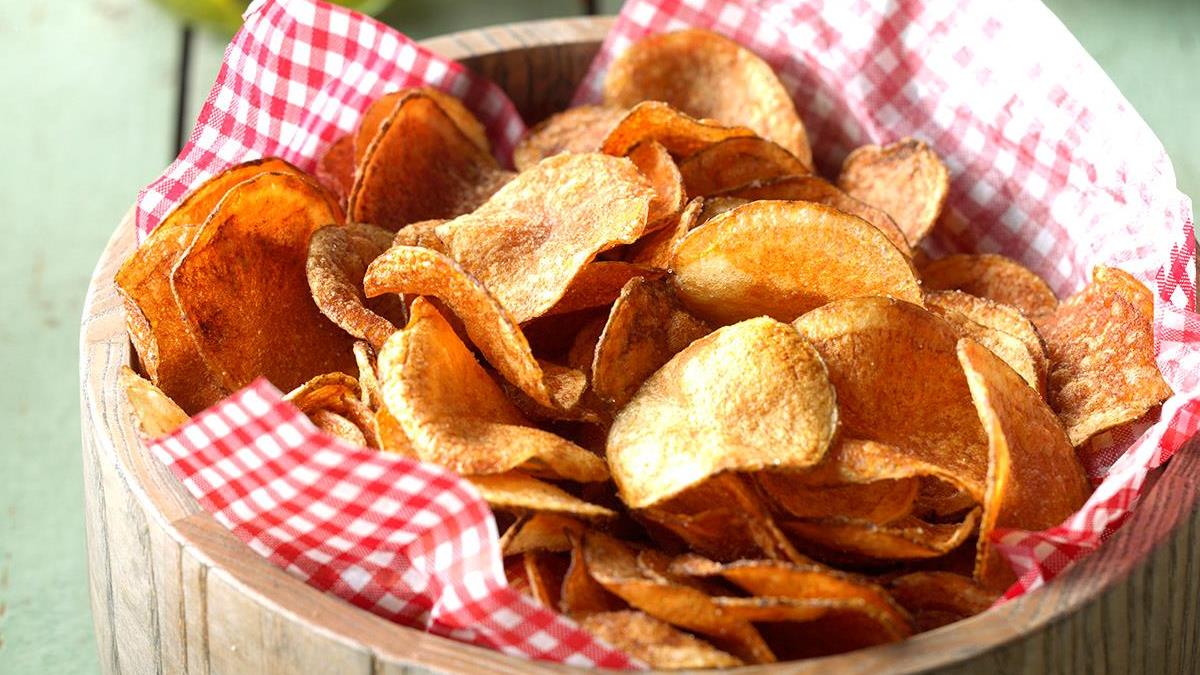Craving for a delicious snack? The answer is Kettle chips! You must be wondering how these tasty crunchy chips evolved. In this comprehensive guide, you will get to know the history and evolution of kettle chips, from its origin to the present day.
Get ready to explore the fascinating world of Kettle chips!
Kettle chips, also known as kettle-cooked potato chips, are a type of potato chip that has been fried in oil or in a pneumatic deep fryer and seasoned with salt. They are typically made from thin slices of potatoes that have been soaked in brine and then fried until golden and crunchy.
Kettle chips have become increasingly popular over the years and are now available in a wide variety of flavors. They are widely considered to be a healthier option than regular fried potato chips, as they contain fewer calories per serving and do not contain any added preservatives or trans fats.
This guide will take an in-depth look at the history, production process, flavor varieties, nutrition facts, health benefits and other interesting facts about kettle chips.
Definition of kettle chips
Kettle chips are a type of potato chip that is characterized by its crunchy texture, thick slices and deep, golden-brown color. The name “kettle chips” is derived from the method of preparation: the potatoes are cooked in small batches in a large metal kettle using only whole potatoes and vegetable oil. This technique was popularized by J.R. Reverend Corby in Wisconsin in the late 1940s; he became known as the “Chipmaker from Chippewa Falls.” Today, kettle chips are widely available and immensely popular snack foods around the world.
Kettle chips stand apart from the typical potato chip for several reasons. First, these chips have a distinct crunchier texture due to their thicker slice and longer cooking time than other potato chips. Second, they are often seasoned with more flavorful ingredients than traditional potato chips, allowing for unique flavor combinations such as garlic pepper or rosemary sea salt. Finally, kettle-style methods of cooking have been used since ancient times; this tradition has continued with modern manufacturers who still use old-fashioned techniques to ensure maximum flavor, color and crunchiness in their products.
Brief overview of the history of kettle chips
Kettle chips are a traditional type of potato chip with a crunchy texture and crisp, robust flavor. They were invented in the 1950s, but their history can be traced back to the 1600s when farmers began frying potatoes, meats, and fish in fat or lard for use as snacks or appetizers. The popularity of this style of cooking eventually spread across Europe and to America by the late 1700s.
In 1958, two brothers from Oregon named Gary and Les Cleveringa took the idea of kettle cooking to a new level by creating a process that kept potato slices intact while still offering a flavorful end product. This process involved soaking slices of Russet Burbank potatoes in salt water for several hours before deep-frying them in small batches until they became golden-brown and crispy. This new snack was called Kettle Chips and it quickly caught on with people who wanted something healthier than traditional fried foods.
Kettle chips soon became popular all over the world as manufacturers began to incorporate different ingredients like herbs and spices into the recipe. Kettle chips are now available in various flavors such as barbecue, sour cream & onion, jalapeno cheddar, honey mustard, BBQ bacon ranch and many more. In addition to these innovations in flavor combinations, companies have also incorporated healthy options into their products by reducing sodium levels, using non-GMO potatoes, eliminating trans fats from the frying process or adding organic ingredients where possible.
The Origins of Kettle Chips
Kettle-style chips have become a ubiquitous part of nearly every kind of snack food aisle. But the origins of these crunchy, salty creations actually dates back hundreds of years.
The first kettle chips were created in 1853 by an Englishman named Joseph Rudiger. Using a cobbled-together setup including a burlap bag, a brick and a kitchen stove, Rudiger crafted a unique method for frying potato slices in small batches for maximum crispness and flavor. The method was adopted by subsequent generations but did not acquire the “kettle chip” moniker until 1953 when a Wisconsin cheese producer named Milt Feigenbaum decided to rename his homemade chips after the equipment he used to make them—little copper kettles.
Feigenbaum saw great potential in his product and began selling it to grocery stores around the Midwest. His success spawned dozens of copycat efforts from competitors who wanted to capitalize on growing consumer demand. Eventually, these copycat efforts gave rise to national brands such as Kettle Foods (the US-based counterpart of Rudiger’s original brand) and Cape Cod Potato Chips that continue to dominate the market today with their myriad flavors and varieties.
In addition to maintaining their traditional production methods, modern manufacturers have also ventured into new frontiers like flavored kettle chips (e.g., sour cream and onion) as well as innovative spinoffs like baked or veggie versions that are lower in fat than their fried counterparts yet still maintain the same irresistible crunch and flavor consumers expect from this time-honored classic snack food.
Introduction of potato chips
Potatoes are a food staple that have been around for centuries, although they have been popularly prepared and eaten in various forms since the 19th century. Before this time, potatoes were traditionally boiled or steamed. It was not until 1853 that American chef George Crum created the iconic chips in Saratoga Springs, New York. He found that when sliced thinly and fried quickly in hot oil, he could create a crunchy snack. Most often served with salt, these potatoes were then called “Saratoga chips” or “crinkle-cut chips” and were an immediate success.
The creation of potato chips caused an almost immediate craze over various other similar snacks—especially those made with other root vegetables like beets and carrots. The American public became enamored with this new way of preparing food, and the demand for these crunchy snacks led to a host of new inventions like “kettle chips” — a type of chip uniquely cooked using indirect heat along with an open flame to create an incredibly crunchy texture.
The evolution of potato chips
Potato chips trace their origins back to the latter half of the 19th century. While there is some debate as to who actually invented them, the most widely accepted story is that a chef named George Crum invented the very first potato chip in Saratoga Springs, New York, in 1853. After receiving an order for fried potatoes that were too thick for his customer’s liking, Crum sliced some potatoes so thin that he thought they couldn’t possibly be eaten with a fork. To his surprise, the dish was a hit and he began serving potato chips to all customers requesting “Saratoga chips”.
From there, production and sale of potato chips quickly spread throughout North America. By 1921 over two million pounds of potato chips were being produced annually in the United States alone! As technological advances increased efficiency and decreased costs of production, nearly every region began manufacturing its own version of “sarasoulou” (potato chip).
In addition to traditional potato chips, numerous variations began popping up around this time period. Kettle-style chips (made with whole potatoes fried in hot oil) became increasingly popular by the 1940s and are still popular today. Other more exotic flavors also appeared during this era including sour cream and onion, cheese and onion, barbecue sauce and ranch dressing – ensuring that every chip lover could find something to enjoy!
The creation of kettle chips
The creation of traditional kettle chips by George Crum dates back to the mid-1800s. At the time, he worked as a chef at the Moon’s Lake House resort in Saratoga Springs, New York. The popular dish was created when a customer complained that their French fries were not thin enough. Crum responded to the critique by slicing potatoes even thinner and deep-frying them in an attempt to frustrate the guest even more. Surprisingly, this created an entirely new and popular dish, which has since become known as “Saratoga chips” or “kettle chips”.
They quickly gained popularity and made its way outside of Crum’s restaurant and into other nearby restaurants around New York City. Eventually, this became a popular snack item throughout the United States and beyond!
III. The Rise of Kettle Chips
Beginning in the 1980s, kettle chips saw an unprecedented surge in popularity and began to gain traction commercially. Home cooks were intrigued by the heightened flavor that came from frying food in a metal pot over a fire, as well as from using traditional methods of chopping up potatoes. The concept of homemade chips first began to enter the mainstream when local chip producers like Jack and Jill’s Kettle Chips appeared on grocery shelves nationwide. In fact, Jack and Jill’s was so successful that they became one of America’s most popular brands within just a few years.
Home cooks also played an important role in the success of kettle chips. As more people experimented with flavors and techniques at home, recipes utilizing pot-frying started to circulate around the nation, inspiring professional chefs to take notice. As restaurants began implementing kettle-inspired cooking methods into their dishes, the popularity of these crunchy chips boomed even more – leading to an explosion of options on supermarket shelves all across America; each with its own special flavor or texture.
The increasing availability and variety of these snacks attracted consumers who preferred something new or unique; customers who wanted a healthier fare than what other chips offered but still wanted something crunchy and tasty to eat on the side with their sandwiches or burgers. As people fell for this less greasy version of fried potato chips, sales skyrocketed – especially when popular flavors like barbeque potato began appearing on store shelves throughout North America.
The introduction of kettle chips to the market
Kettle chips are a type of flavored potato chips that have become increasingly popular in the past few decades. Kettle-style chips were introduced to the market in 1982 by Steve Sullivan, a chef and restaurateur from suburban Minneapolis, Minnesota. Sullivan took his inspiration for the recipe from a restaurant he had visited on business in Europe that served fried potatoes “Amandel-knabbers” which were caramelized slices of fried potato cut into big pieces and served with various sauces.
Sullivan developed his own version, baking potato halves instead of frying them. He experimented with different flavors until settling on a combination of olive oil and sea salt which he dubbed ‘Kettle Chips’ because they were cooked in small batches in kettles over an open fire. In 1985, Sullivan sold his company to an investor group and relocated to Bethesda, Maryland where he continued to develop new products and recipes for Kettle Chips.
The success of kettle chips in the market
The recent success of kettle chips has been credited with the increased demand in healthier snack foods. Unlike traditional potato chips that are usually fried or baked, kettle chips are cooked in a deep fryer with a small amount of oil to give them a crunchy texture, while remaining low in fat content. The popularity of this type of chip can be attributed to the improved health awareness among consumers who are looking for snacks that are both tasty and nutritious.
In addition, kettle chips are renowned for their hearty flavor, which is achieved by slowly cooking each chip in a fryer to bring out more flavor. They also offer a wide range of flavors apart from the original salted variety such as sour cream & onion, cheddar & sour cream, honey dijon, and many more popular options. This helps consumers choose from a variety of flavors that best suits their palate and dietary preferences.
The convenience and availability of these chips have contributed to its success as well. Kettle cooked chips come pre-packaged and ready to eat making them an ideal on-the-go snack or quick bite during meals throughout the day. Furthermore these snacks can be found anywhere from regular groceries stores to specialty shops giving them widespread accessibility wherever you go!
The expansion of the kettle chips market
The popularity of kettle chips has resulted in an increased demand for these crunchy snacks. In the past two decades, the kettle chips market has grown significantly, with more than 50% increase in sales according to a report by Euromonitor International. This growth can be attributed to several factors.
One of them is the wider variety of flavors available which caters to all types of taste palates. Additionally, improvements in manufacturing processes and packaging technologies have allowed for economical production and extended shelf lives, enabling better affordability and wide availability of kettle chips across many countries in Europe and North America.
Kettle chips are also being marketed as a healthy snack option as many brands use only natural ingredients such as sunflower or canola oil for flavorings and cooking processes that do not involve chemical preservatives or artificial colors or flavors. This healthier snack option has gained traction among health-conscious consumers who rely on healthier alternatives when it comes to snacking choices.
Conclusion
It is clear that the humble kettle chip has made a large impact on the snack food industry. What began as an experiment by two passionate entrepreneurs over 100 years ago, has grown to become one of America’s most popular snacks. Over the years, manufacturers have worked hard to perfect the traditional recipe, creating new flavors and different types of chips to appeal to different customer tastes. Kettle chips are now widely available in supermarkets, convenience stores and online retailers, making them easily accessible to a wide variety of consumers.
No matter how much things have changed over time, one thing remains constant- the classic potato chip recipe with its unique flavor profile and crunchy texture that we all know and love. So next time you reach for a bag of chips, consider investing in some high quality kettle chips- you won’t be disappointed!
FAQ’s
What is the history of Kettle Chips?
Kettle Chips were first introduced in the United States in 1982. They were created by Cameron Healy, who started the company with his business partner, Jeff Liese.
Who invented the kettle chip?
The kettle chip was invented by Cameron Healy, who co-founded the Kettle Foods company with Jeff Liese.
What was the first kettle chip?
The first kettle chip was the Original flavor, which is still one of Kettle Chips’ most popular varieties today.
When were Kettle brand chips invented?
Kettle brand chips were invented in 1982.
Why is it called Kettle Chips?
They are called Kettle Chips because they are made in batches in large kettle-style cooking equipment.
What defines a kettle chip?
Kettle chips are defined by their cooking process. They are cooked in batches in hot oil in a kettle, which gives them a unique texture and flavor.
What is the history of chips?
Potato chips were first invented in 1853 by George Crum, a Native American chef in Saratoga Springs, New York. They became popular quickly and are now a ubiquitous snack food around the world.
What is different about Kettle Chips?
Kettle Chips are different from other potato chips because of their unique cooking process, which gives them a crunchy texture and a distinctive flavor. They are also made with high-quality, all-natural ingredients.
What’s special about kettle cooked chips?
Kettle-cooked chips are special because they are cooked in small batches, which allows for more attention to detail and a higher-quality finished product. The cooking process also gives them a crispy texture and a distinctive flavor.
Which country owns Kettle Chips?
Kettle Chips is owned by the Campbell Soup Company, which is based in the United States.
See Also-
- Best kettle for chemex
- Best glass tea kettle
- Best electric pour over kettle
- Best electric kettle without plastic
- Best electric kettle with tea infuser

